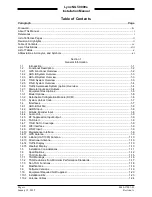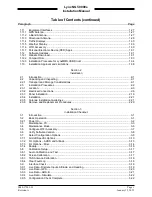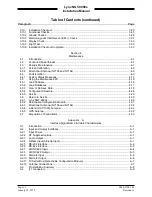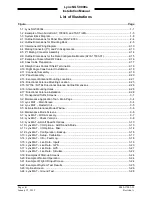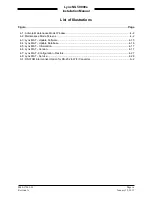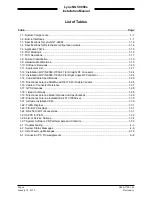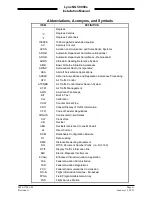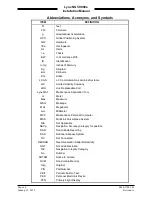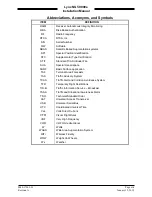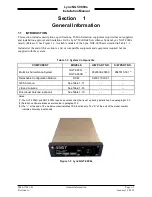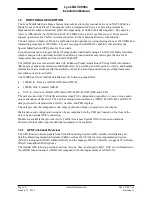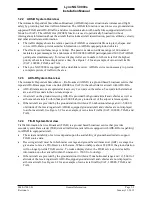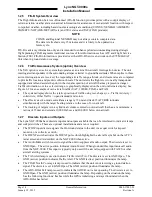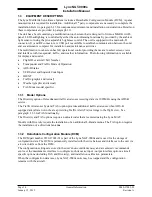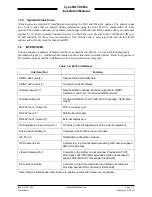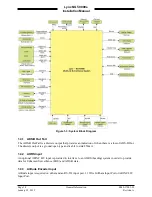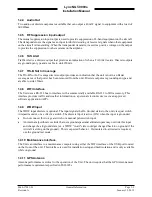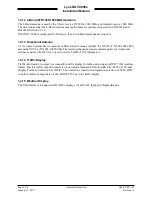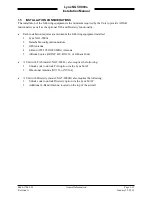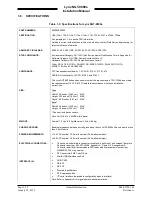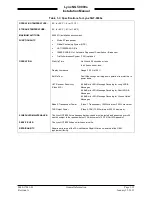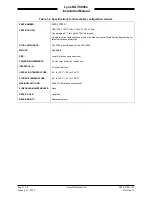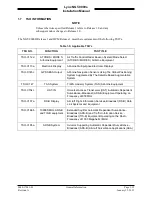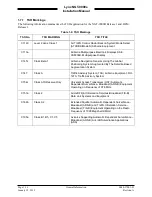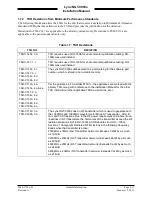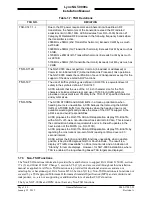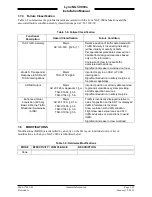
Lynx NGT-9000s
Installation Manual
1.2.5 FIS-B System Overview
The Flight Information Services - Broadcast (FIS-B) function provides pilots with a cockpit display of
certain aviation weather and aeronautical information for awareness of own aircraft location with respect
to reported weather, including hazardous meteorological conditions (CONUS/ NEXRAD /AIRMETS/
SIGMETS/ NOTAMS/ METARS, etc) and SUA status and TAF (FIS-B products).
NOTE
CONUS and Regional NEXRAD may not always contain complete data.
The data is refreshed every 15 minutes and it is likely to be updated in a
future cycle.
FIS-B is advisory information only and is intended to enhance pilot decision-making during strategic
flight planning. FIS-B augments traditional sources of this information such as ATC and Flight Service
Station (FSS). FIS-B information is provided over the ADS-B Services network on the 978 MHz UAT
link when in ground station coverage.
1.2.6 Traffic Awareness System (option) Overview
The TAS option is an active system that operates as an aircraft-to-aircraft interrogation device. The unit
interrogates transponders in the surrounding airspace similar to ground based radar. When replies to these
active interrogations are received, the responding aircraft’s range, altitude, and closure rates are computed
to plot traffic location and predict collision threats. The unit alerts the flight crew to nearby transponder
equipped aircraft and assists the pilot in the visual acquisition of aircraft that may represent a danger.
Traffic information, out to a selected range, is graphically displayed on the unit or alternate display. See
Figure 1-2 for an example of own aircraft traffic (UAT, 1090ES, TIS-B, and TAS).
•
The system display shows the relative position of traffic using text, shapes (i.e., Traffic Advisory =
solid circle; Other Traffic = open diamond) and colors.
•
The effective active-mode surveillance range is 35 nmi and track 35 ATCRBS intruders
simultaneously with the target bearing relative to the nose of own aircraft.
•
The tracking of targets is in a cylindrical volume centered on own aircraft that has, at a minimum, a
radius of 35 nmi and extends 10,000 ft above and 10,000 ft below own aircraft.
1.2.7 Discrete Inputs and Outputs
The Lynx NGT-9000s have discrete inputs and outputs available that can be interfaced to indicator lamps
and cockpit switches. These are optional installations and are not required.
•
The WOW input discrete signals the On Ground status to the unit via a squat switch, airspeed
monitor, or a collective switch.
•
The IDENT switch activates the IDENT pulse which highlights the aircraft’s symbol on the ATC’s
radar screen and is identified on the NGT-9000 when active.
•
The Audio Mute switch is used to signal the unit to suppress all audio output. The discrete is set to
GND/Open. The active position indicates Audio Muted. When grounded this input mutes all audio
from the NGT-9000. This input is typically only used if the aircraft equipped with TAWS or other
aircraft alerting systems.
•
The TAS Alert lamp is used to indicate Traffic Alert (TA). The discrete is set to GND/Open. The
GND (active) position indicates Traffic Alert. The GND (active) position illuminates the lamp.
•
The TIS-B Not In Coverage lamp is used to indicate that the unit is not receiving a ground station
signal. The discrete is set to GND/Open. The GND (active) position illuminates the lamp.
•
The ADS-B Out Fail lamp is used to indicate that ADS-B out is not operating. The discrete is set to
GND/Open. The GND (active) position illuminates the lamp. Depending on the situation the lamp
has the following functions: flashes while the GPS is initializing and stays illuminated when the
ADS-B Out has failed.
Page 1-4
General Information
0040-17001-01
January 15, 2015
Revision A

